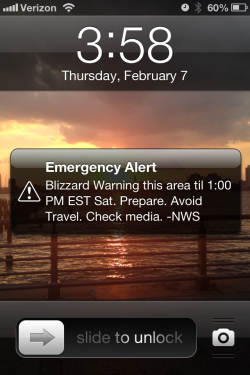If you live along the Northeastern Seaboard, there’s a good chance your mobile phone buzzed or beeped Thursday afternoon with a text alert like the one shown at left. And if you don’t, there’s a decent chance you witnessed the fallout on Twitter anyway.
Why did some people get the alerts while others sitting right next to them did not? Did half the country download some emergency-alert app that they’ve since forgotten about? If you didn’t get the message, does that mean you’re safe? Or doomed?
No, no, and no. The alerts are sent via the Wireless Emergency Alert system, developed by the FCC and FEMA and implemented starting in April 2012. They appear on WEA-equipped mobile phones by default, regardless of what apps you have active. As ABC News explained in November, when Sandy spurred a similar (if seemingly more justified) emergency bulletin, the discrepancy is merely a matter of which phones have been outfitted by their carriers to display the alerts. Have an iPhone 4S or 5 on Verizon? You probably got the memo. Same phone on AT&T? No alert: It seems the carrier’s LTE network does not support the system. I’ve asked AT&T’s press team for further explanation and will update if they reply. (Update, 5:35 p.m.: Here is AT&T’s list of devices that support the alerts, and here is Verizon’s.)
The alerts seem like a great idea in theory, although today’s message wasn’t exactly overflowing with actionable intel. Reactions on social networks and in the newsroom where I’m sitting right now suggest the alert’s most immediate effect was to make those who got it wonder why they did and those who didn’t get it wonder why they didn’t.
But hey, here you are finding out the answer. So, if nothing else, hooray for the sage advice to “check media.” Oh wait, were you hoping to learn something about the actual blizzard? Try Weather Underground’s page on Winter Storm Nemo.
